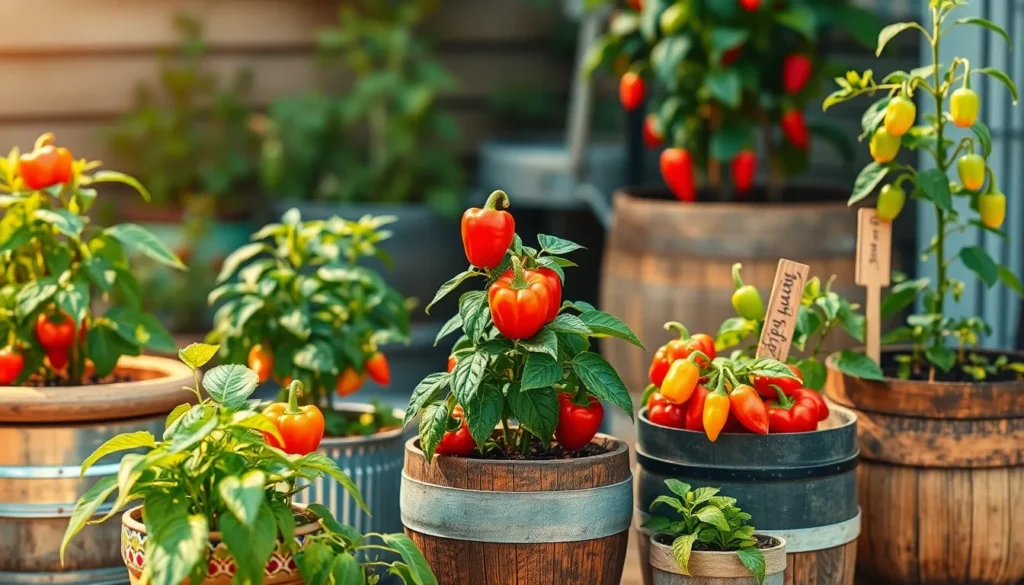Imagine stepping onto your balcony or patio and being greeted by vibrant, glossy peppers swaying gently in the breeze, each plant a testament to your green thumb. Whether you’re a beginner gardener or someone with years of experience, growing peppers in containers offers a satisfying and space-efficient way to cultivate these colorful additions to your culinary adventures.
Peppers are not just a treat for the eyes; they are a flavorful powerhouse in any kitchen, adding layers of taste and spice to your meals. This article will guide you through 13 effective strategies to ensure your container peppers thrive, from selecting the right variety to managing light and water needs.
For those just starting their gardening journey, container gardening with peppers is a fantastic way to dip your toes into the soil without overwhelming commitment. Experienced gardeners will find that growing peppers in containers opens up new possibilities for optimizing space and experimenting with different growing conditions.
You’ll learn how to choose the perfect container size, understand the nuances of soil composition, and master the art of watering to prevent the dreaded over- or under-watering conundrum. As you embark on this pepper-growing adventure, you’ll gain confidence and satisfaction from each sprout and pepper harvested, making your gardening experience both rewarding and fun.
Choosing the Ideal Pepper Varieties
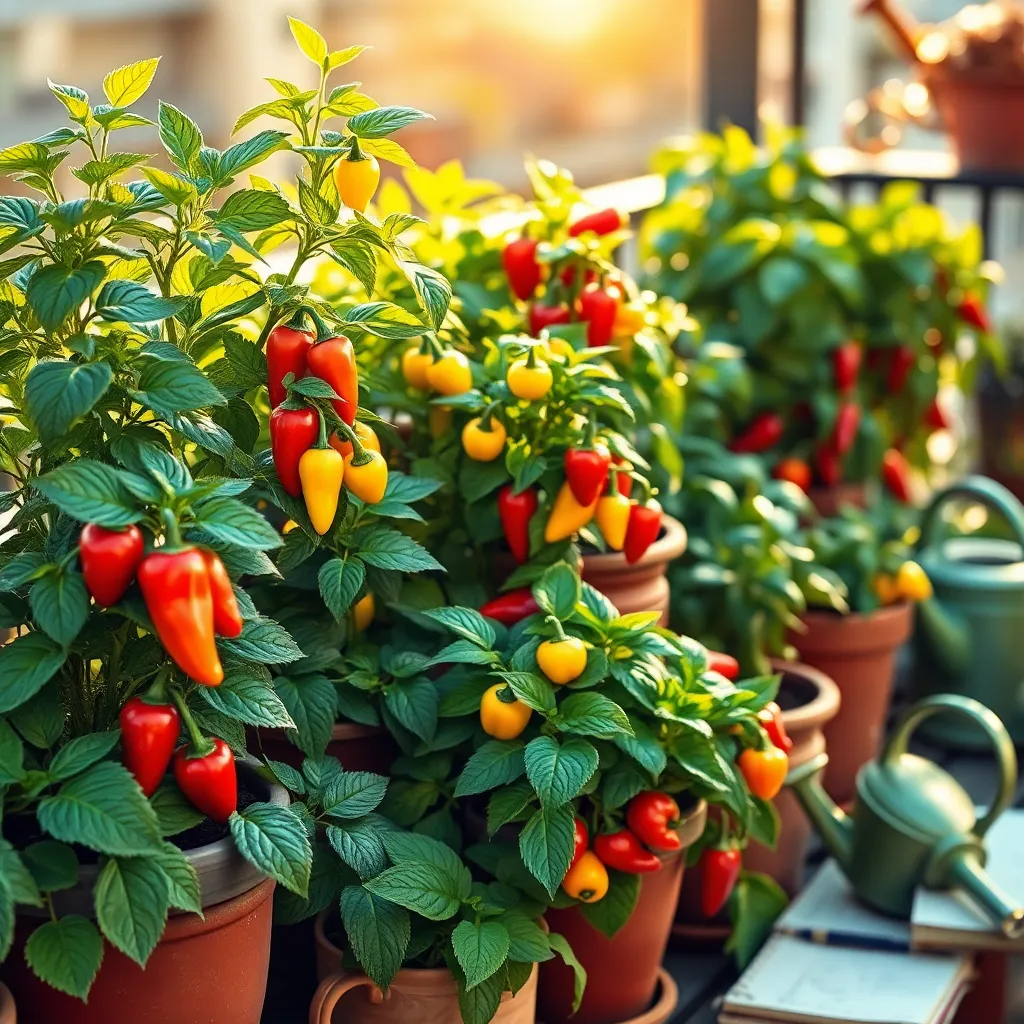
Choosing the right pepper variety is crucial for successful container gardening, as some types are better suited to confined spaces. Compact or dwarf varieties like ‘Mini Bell’, ‘Jalapeño Early’, and ‘Hungarian Wax’ are ideal choices because they thrive in smaller environments while still producing a bountiful harvest.
Consider your local climate when selecting pepper varieties, as some peppers need longer growing seasons to mature fully. In cooler climates, opt for varieties like ‘Cayenne’ or ‘Cherry Pepper’, which mature more quickly and can be harvested sooner, ensuring you beat the first frost.
Additionally, think about the level of heat you desire in your peppers, as this will affect your choice. For those who prefer milder flavors, ‘Banana Peppers’ or ‘Poblano’ offer a gentle heat, while enthusiasts of spicy flavors might select ‘Habanero’ or ‘Thai Hot’, which pack a punch.
When growing peppers in containers, ensure they receive adequate sunlight, as peppers require at least 6 to 8 hours of direct sunlight daily to flourish. Use a pot that is at least 12 inches deep, filled with well-draining potting soil enriched with organic matter to support healthy root development.
Selecting the Perfect Container Size
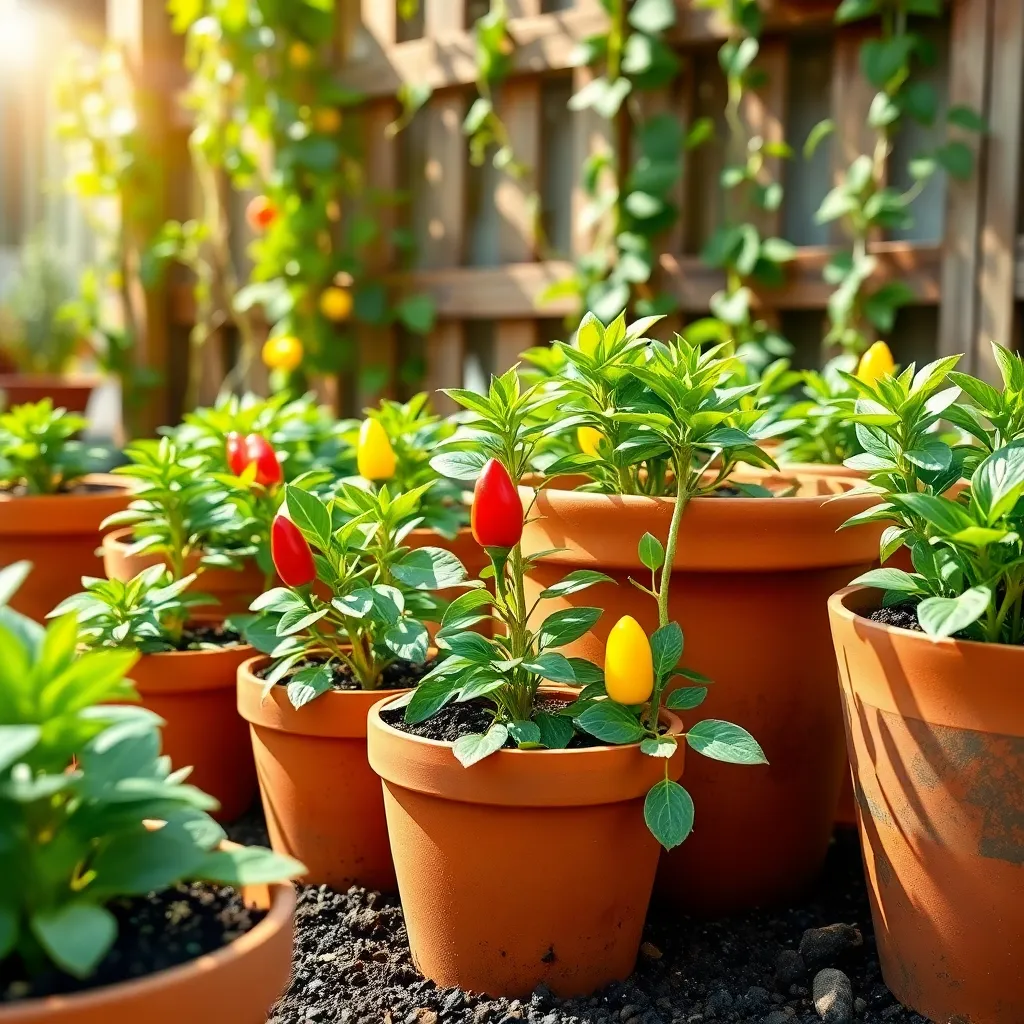
When selecting a container for growing peppers, it is important to choose one that is at least 12 inches deep and wide. This size allows the pepper plant to develop a strong root system, which is crucial for supporting healthy growth and abundant fruit production.
For larger pepper varieties, such as bell peppers, you might need a container that is even bigger, around 14 to 18 inches in diameter. This extra space ensures the plant has enough room to thrive without becoming root-bound, which can stunt growth and reduce yields.
Consider using containers with adequate drainage holes to prevent water from accumulating at the bottom, which can lead to root rot. If your chosen container doesn’t have enough drainage, you can easily drill additional holes to ensure excess water can escape.
For advanced gardeners aiming for a more robust pepper harvest, consider using self-watering containers. These containers help maintain consistent moisture levels, reducing the frequency of watering while ensuring the plant receives adequate hydration, especially during hot weather.
Optimal Potting Mix for Peppers
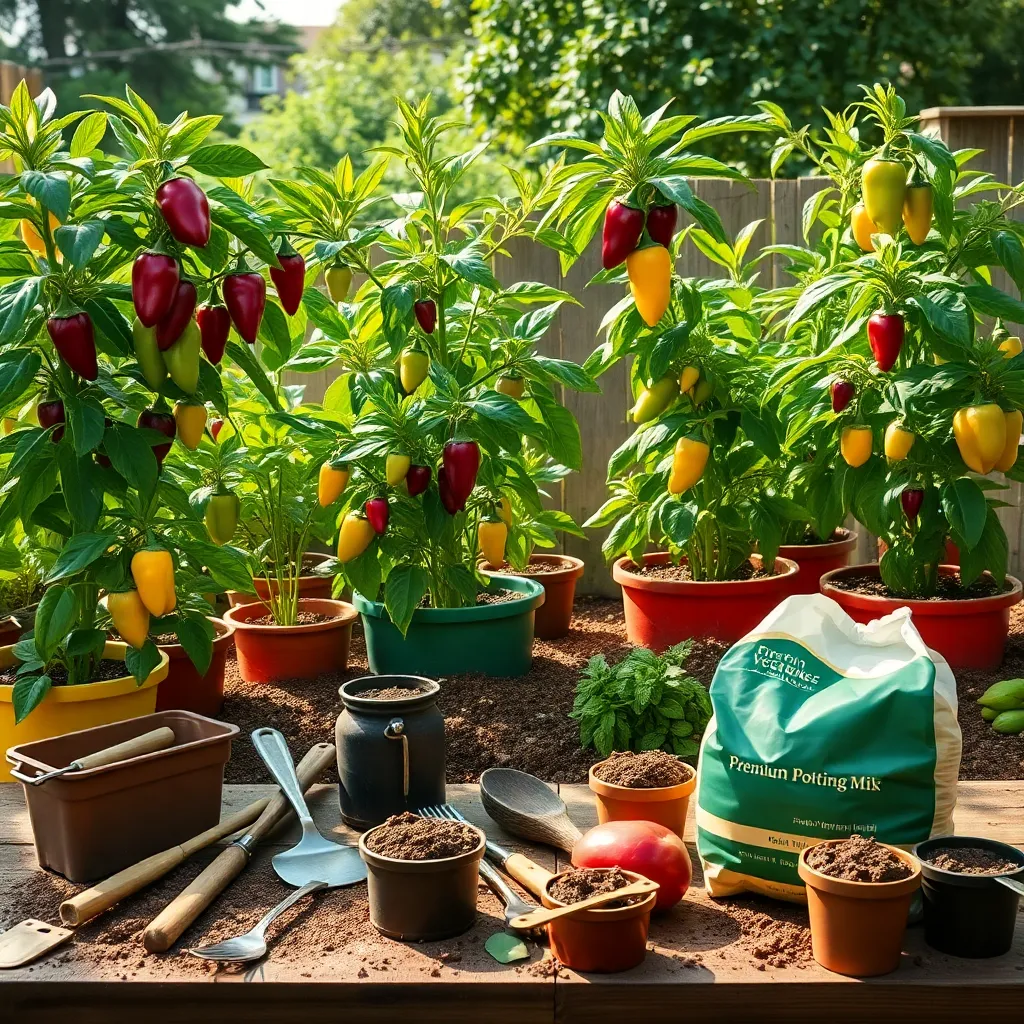
When growing peppers in containers, using the right potting mix is crucial to ensure healthy plant development. A well-draining mix is essential to prevent root rot and promote optimal growth. Consider using a blend that includes materials like peat moss, perlite, and vermiculite. These components will help maintain moisture while ensuring adequate air circulation around the roots.
Incorporating organic matter into your potting mix can greatly benefit pepper plants. Adding compost or well-rotted manure can provide essential nutrients and improve soil structure. This not only enriches the mix but also encourages beneficial microbial activity that supports plant health. For beginners, pre-mixed potting soils designed specifically for vegetables can be a convenient option.
Advanced gardeners might consider customizing their potting mix for peppers based on specific needs. Experimenting with ratios can help create a unique blend that maximizes growth in your particular climate. For instance, in hotter regions, increasing the proportion of peat moss helps retain moisture, while in humid areas, more perlite can enhance drainage. Regular testing and adjusting based on plant response can lead to a thriving container garden.
It’s also important to monitor the pH level of your potting mix to ensure it falls within the ideal range for peppers, which is between 6.0 and 6.8. Adjusting pH can be done by incorporating lime to raise it or sulfur to lower it, depending on your starting point. Consistently checking and maintaining this balance will support nutrient uptake and robust growth throughout the growing season.
Ensuring Proper Drainage Solutions
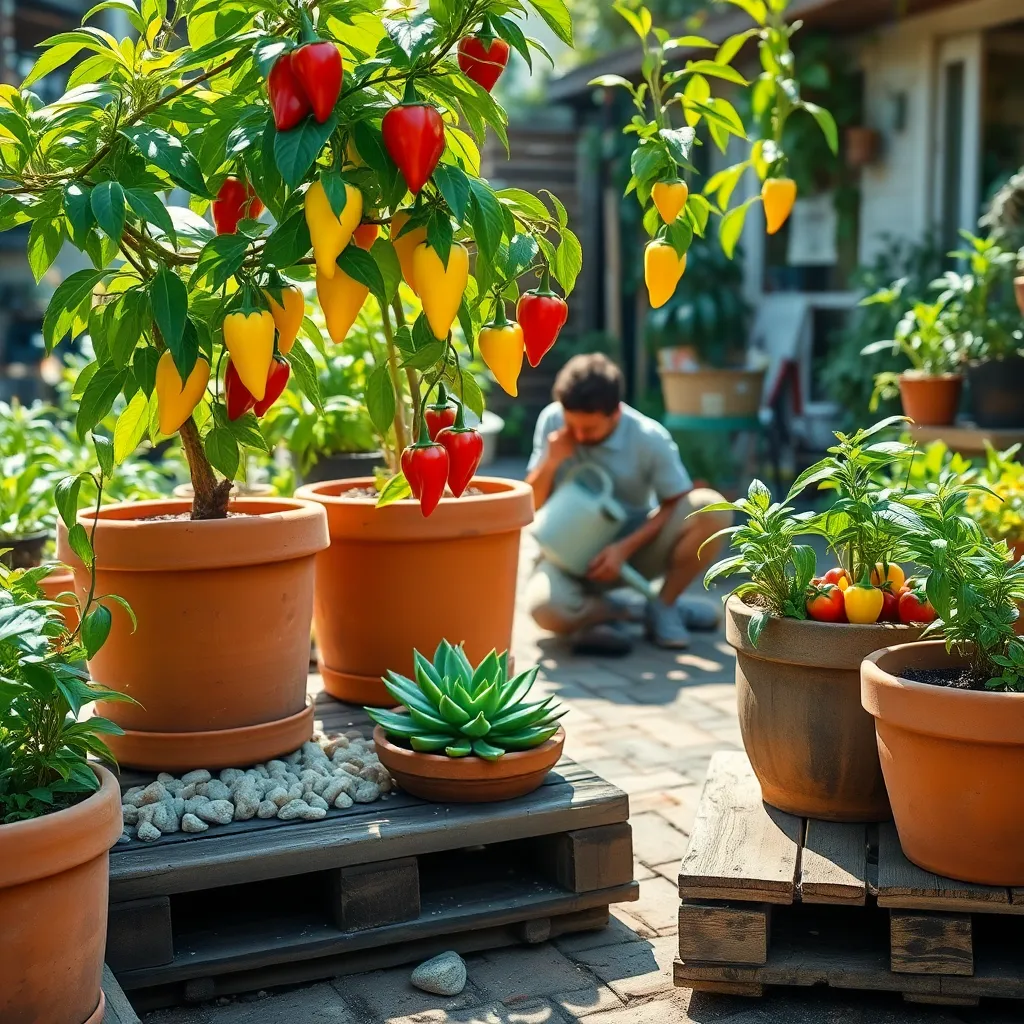
Proper drainage is crucial when growing peppers in containers to prevent waterlogged soil and root rot. Ensure your containers have ample drainage holes at the bottom, which allows excess water to escape easily.
Utilizing a layer of small stones or gravel at the base of the container can further enhance drainage. This layer prevents soil from compacting at the bottom, ensuring water flows freely and roots have access to necessary air.
For gardeners using saucers under their pots, it’s important to regularly empty them to prevent stagnant water from causing root issues. Monitoring the weight of the container can also give you a sense of soil moisture levels; a light pot likely needs watering, while a heavy one might be too wet.
For advanced gardeners, consider using a well-draining potting mix that includes components like perlite or coarse sand. These amendments help maintain a balance of moisture and air within the soil, crucial for healthy pepper growth.
Planting Techniques for Container Peppers
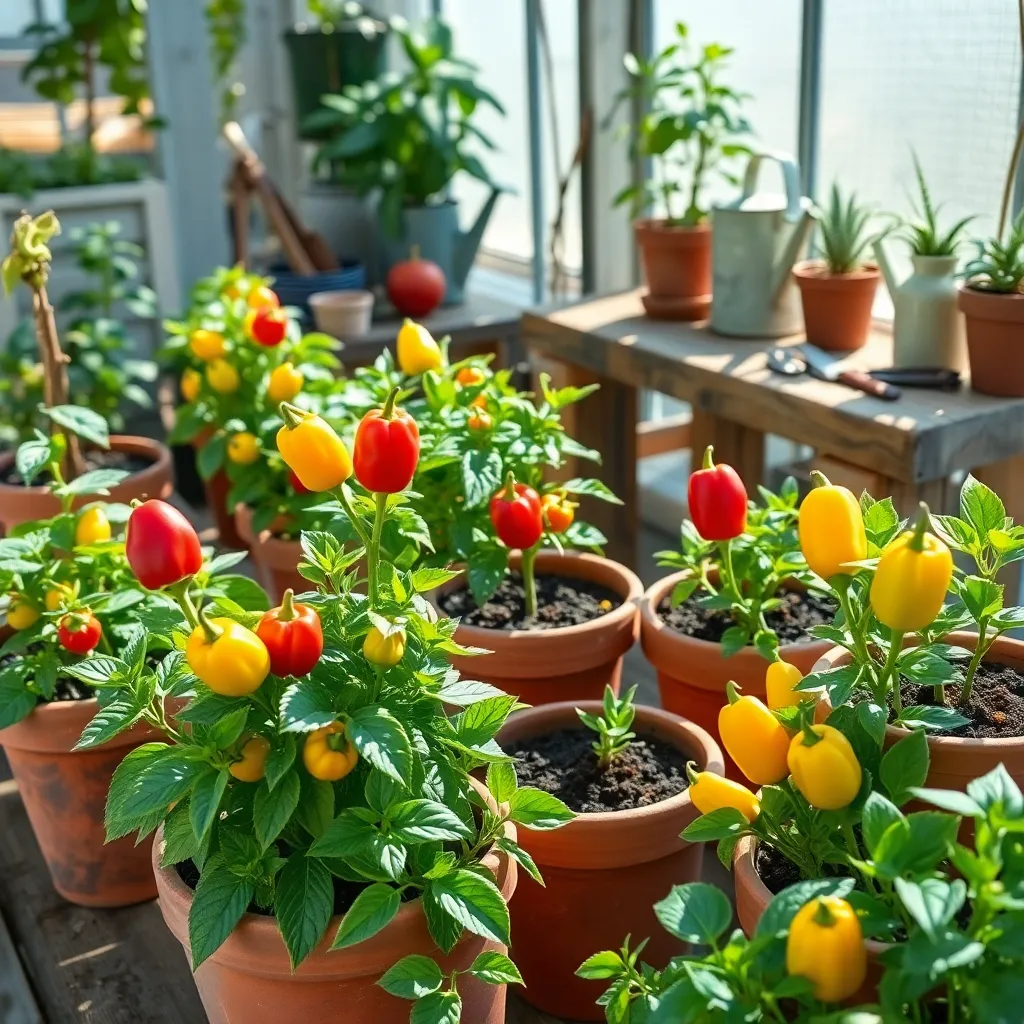
To start, choose a container that is at least 12 inches deep to accommodate the pepper plant’s root system. Ensure the container has sufficient drainage holes to prevent waterlogging, which can lead to root rot.
Fill the container with a high-quality potting mix rich in organic matter. A mix that includes compost or well-rotted manure can provide essential nutrients and improve soil structure.
Plant pepper seedlings after the last frost date to avoid cold damage. Ensure they are planted at the same depth as they were in their nursery containers, and gently firm the soil around the base.
Position the container in a location that receives at least 6-8 hours of sunlight daily. For optimal growth, regularly rotate the pot to ensure even light exposure on all sides of the plant.
Water the peppers consistently, keeping the soil moist but not soggy. Consider using a drip irrigation system or self-watering containers to maintain soil moisture levels, especially during dry spells.
Fertilize the peppers every two weeks with a balanced liquid fertilizer to encourage vigorous growth and fruit production. For more experienced gardeners, using a fertilizer with higher potassium content can enhance fruit size and flavor.
Sunlight Needs and Placement Tips
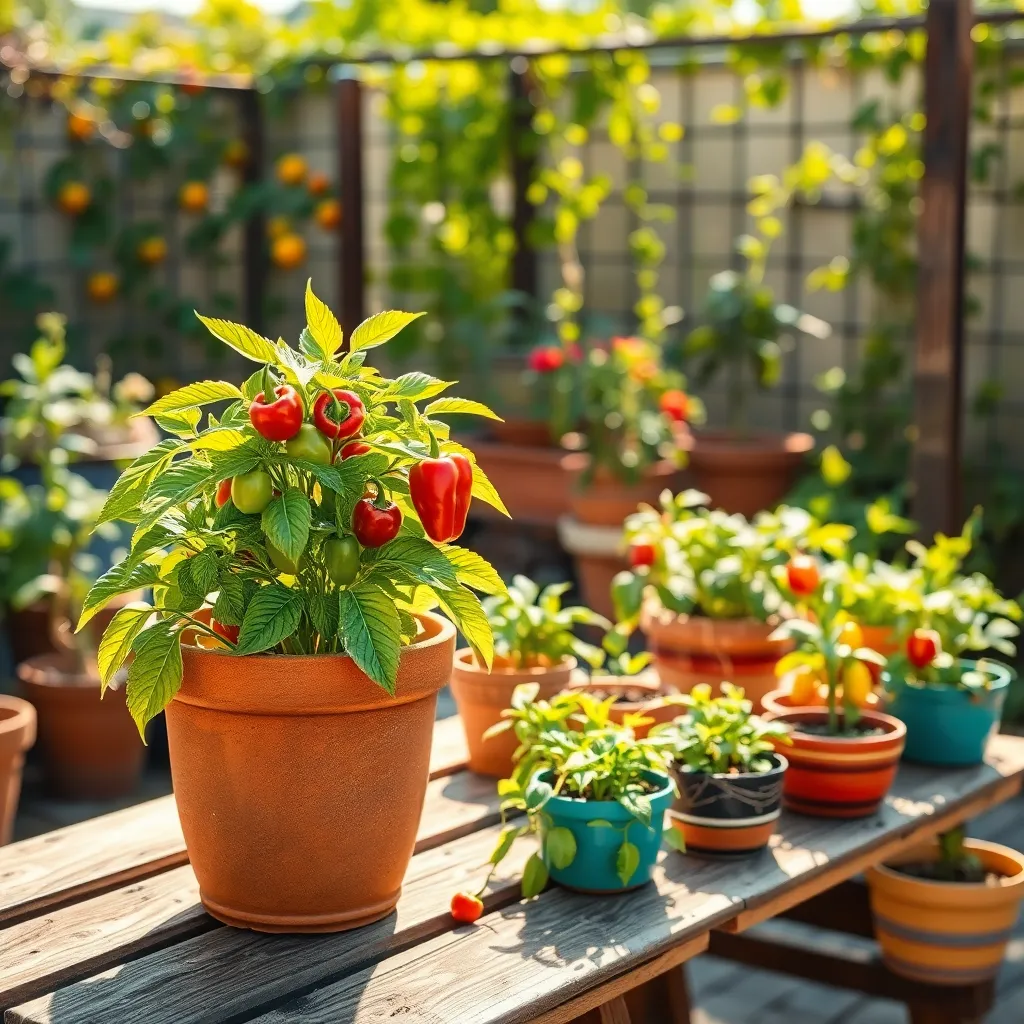
To grow healthy peppers in containers, ensuring they receive the right amount of sunlight is crucial. Peppers thrive when they get at least 6 to 8 hours of direct sunlight each day, so placing your containers in a sun-drenched spot is essential.
Look for a location that receives consistent sunlight throughout the day, such as a south or west-facing balcony or patio. If you’re limited on space, consider using portable plant caddies to move your pepper containers throughout the day to maximize sun exposure.
For those who live in particularly hot climates, providing some afternoon shade can prevent your peppers from getting scorched. You can achieve this by strategically placing taller plants or using a shade cloth during the hottest parts of the day.
In addition to sunlight, ensure your containers are positioned where they can benefit from good air circulation. This helps in preventing fungal diseases and promotes strong, healthy growth for your pepper plants.
Watering Strategies for Healthy Growth
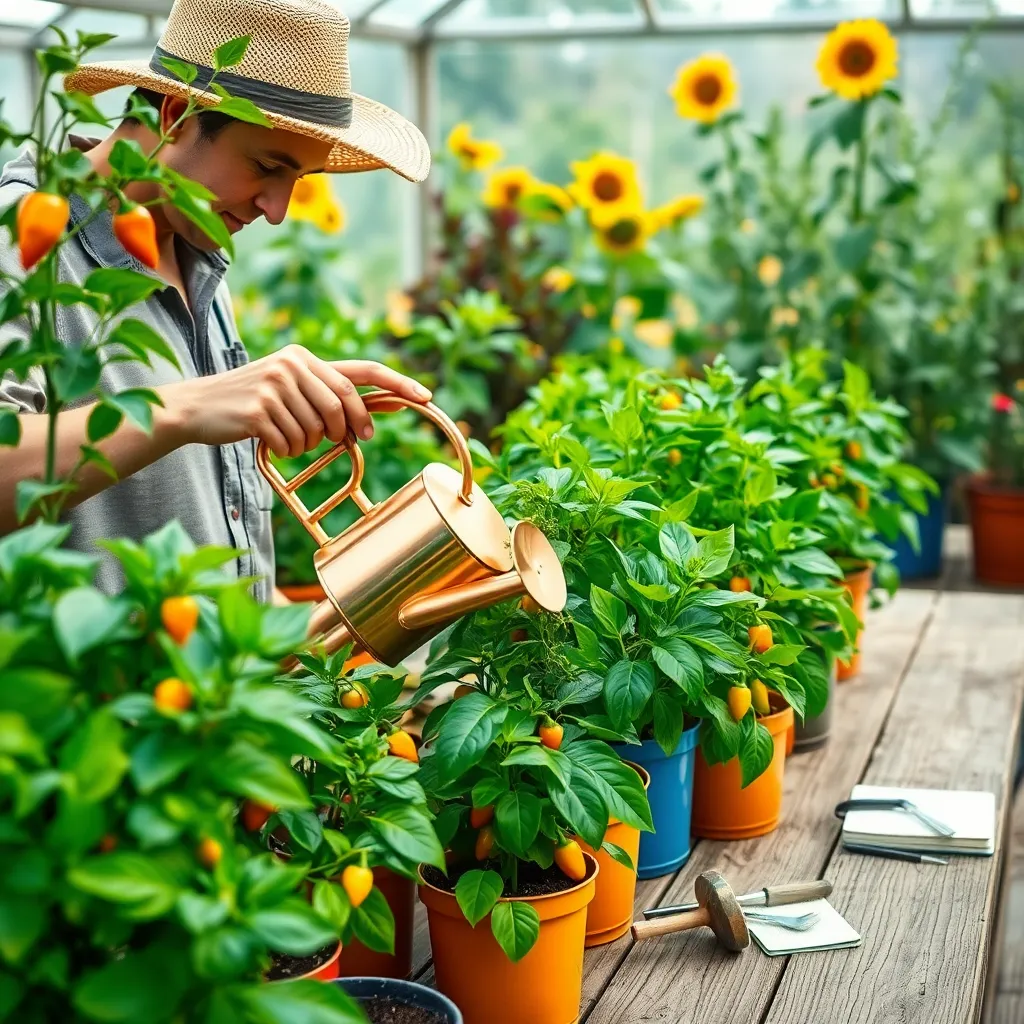
Watering is crucial for growing healthy peppers in containers, as it directly impacts their growth and yield. It’s essential to ensure that the soil remains consistently moist but never waterlogged, as peppers thrive in well-draining environments.
For beginners, a good practice is to water your pepper plants when the top inch of the soil feels dry to the touch. This typically means watering every 2-3 days, but frequency can vary based on temperature and humidity levels.
Advanced gardeners might consider using a moisture meter to get precise readings and avoid the guesswork. These devices can help in maintaining optimal moisture levels by indicating exactly when the plants need water.
Consider using a self-watering pot or adding a layer of mulch to retain moisture and reduce the frequency of watering. Mulch also helps in maintaining a stable soil temperature, which is beneficial during hot summer days.
To avoid root rot, ensure that your containers have adequate drainage holes. Placing a saucer under the pot can catch excess water, but remember to empty it to prevent stagnant water from harming the roots.
Fertilizing Peppers in Containers
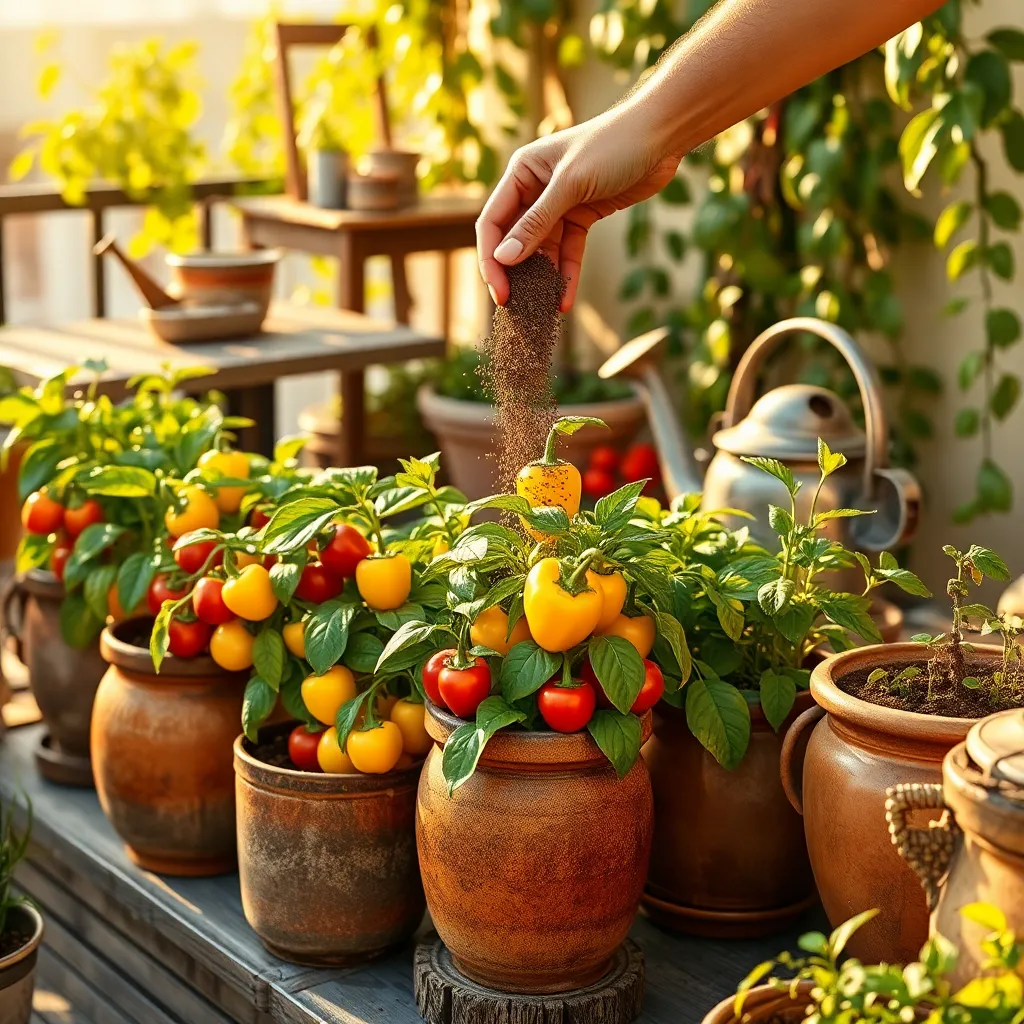
Proper fertilization is crucial for growing peppers in containers, as it helps ensure they have the nutrients needed to thrive. Begin by selecting a balanced, slow-release fertilizer, such as a 10-10-10, which can be mixed into the soil at planting time to provide a steady nutrient supply.
In addition to slow-release fertilizers, consider using a liquid fertilizer every two to four weeks during the growing season. Water-soluble fertilizers with a higher phosphorus content, like a 5-10-5, can promote flowering and fruit development, enhancing your pepper yield.
Monitor your plants regularly for signs of nutrient deficiency, such as yellowing leaves or stunted growth, which may indicate that additional feeding is necessary. Foliar feeding, where you spray a diluted fertilizer solution directly onto the leaves, can be an effective way to quickly address such deficiencies.
For experienced gardeners looking to maximize their harvest, consider supplementing with specialized micronutrients like calcium and magnesium, which are vital for pepper plants. Regularly check the soil’s pH level, aiming for a range of 6.0 to 6.8, to ensure optimal nutrient uptake and healthy plant growth.
Managing Pests and Diseases Effectively
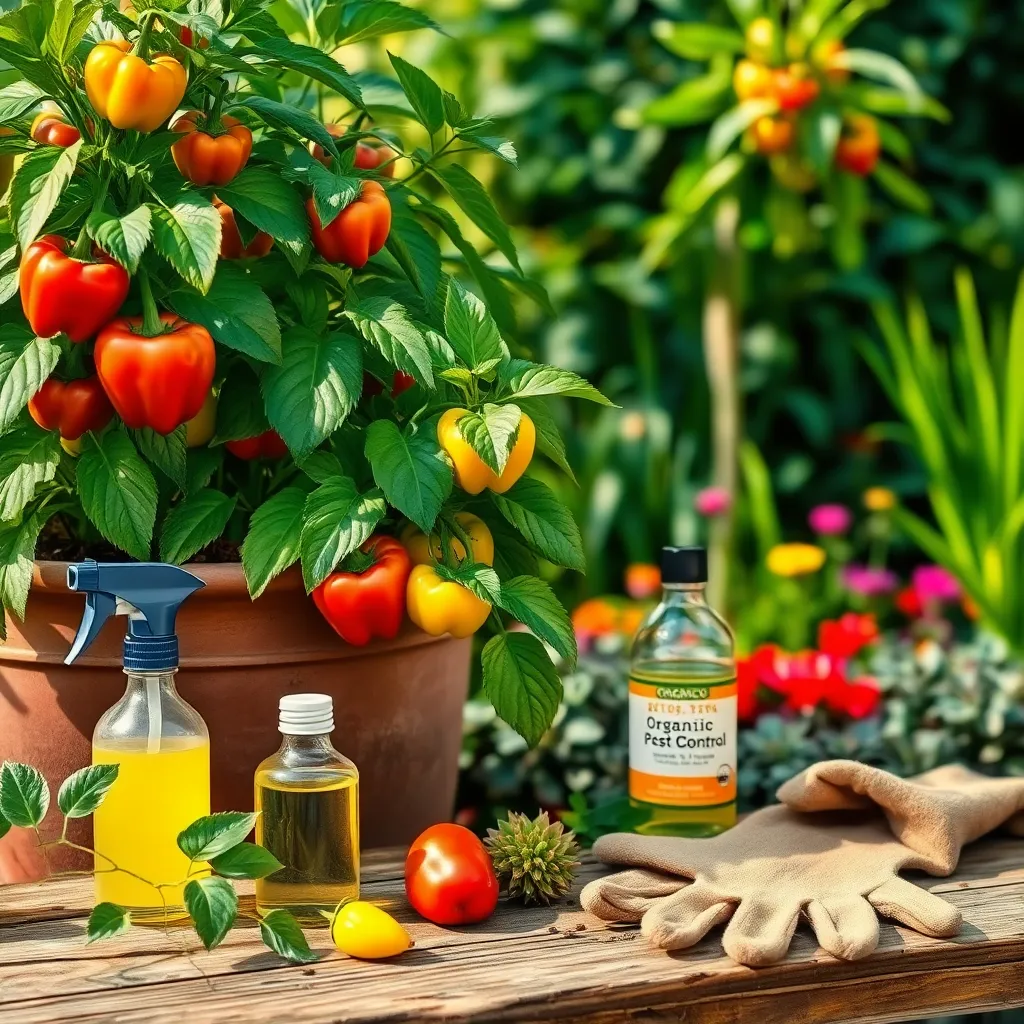
To manage pests and diseases effectively in container-grown peppers, start by keeping a close eye on your plants. Regularly inspect the leaves and stems for any signs of damage or unusual coloring, as early detection is crucial for effective management.
Maintain cleanliness around your peppers by removing fallen leaves and debris from the soil surface. These can harbor pests and diseases, so keeping the area tidy minimizes risks.
Consider using natural pest deterrents such as neem oil or insecticidal soap, which are effective against common pests like aphids and spider mites. Applying these treatments in the early morning or late evening helps prevent leaf burn due to direct sunlight.
For disease prevention, ensure your peppers have adequate spacing to promote air circulation, reducing the likelihood of fungal infections. Additionally, using a well-draining potting mix reduces the risk of root rot, a common problem in container gardening.
Pruning and Supporting Pepper Plants
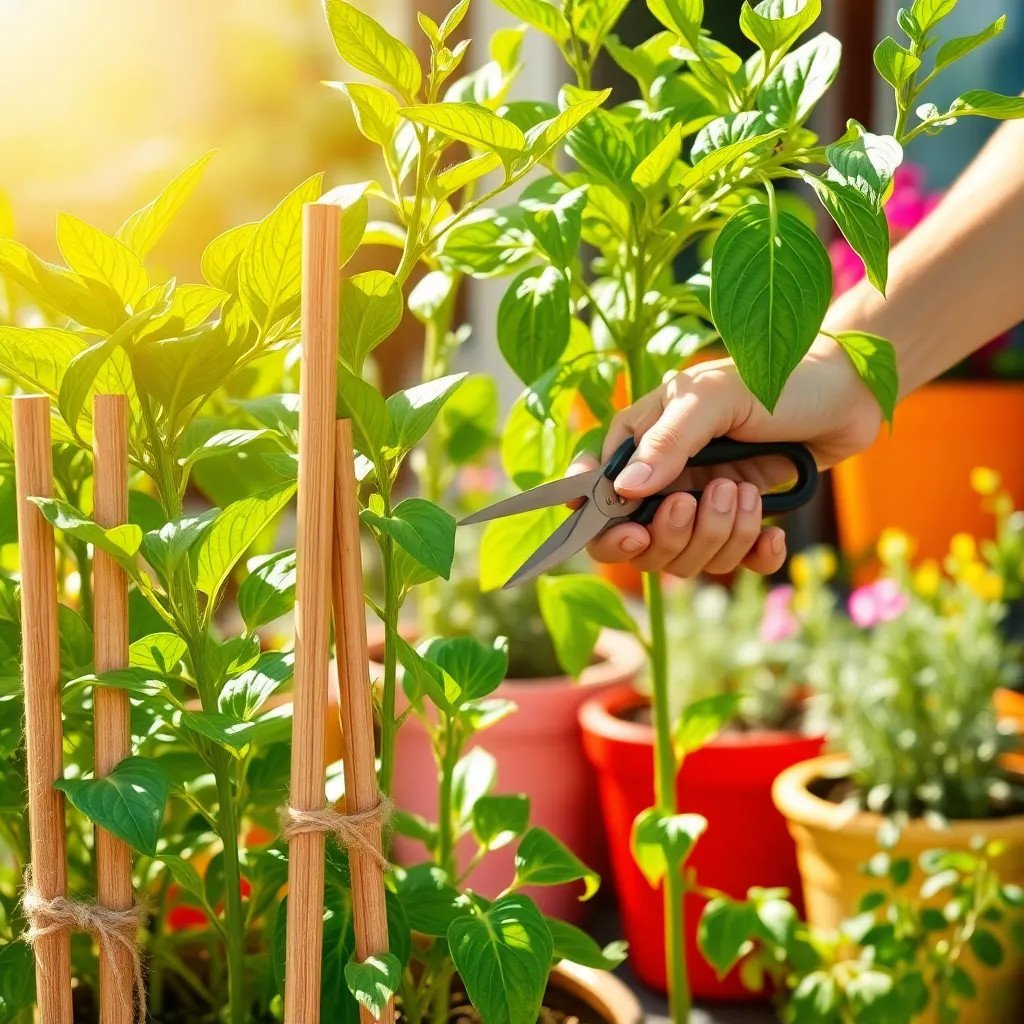
Pruning pepper plants is essential to promote healthy growth and increase yields. Start by removing the lower leaves and any branches that show signs of disease or damage, which improves air circulation and reduces the risk of pests.
As your pepper plants grow, you should also pinch out the early flower buds. This encourages the plant to focus on developing a strong root system and sturdy stem before fruiting, ultimately leading to more abundant harvests.
Supporting your pepper plants is crucial, especially as they begin to bear fruit. Use stakes or cages to keep the plants upright and prevent branches from breaking under the weight of the peppers.
Choose a sturdy stake or a tomato cage, and gently tie the main stem with soft ties to provide adequate support without damaging the plant. Regularly check the ties to ensure they are secure but not too tight, allowing room for growth as the season progresses.
Temperature and Humidity Considerations
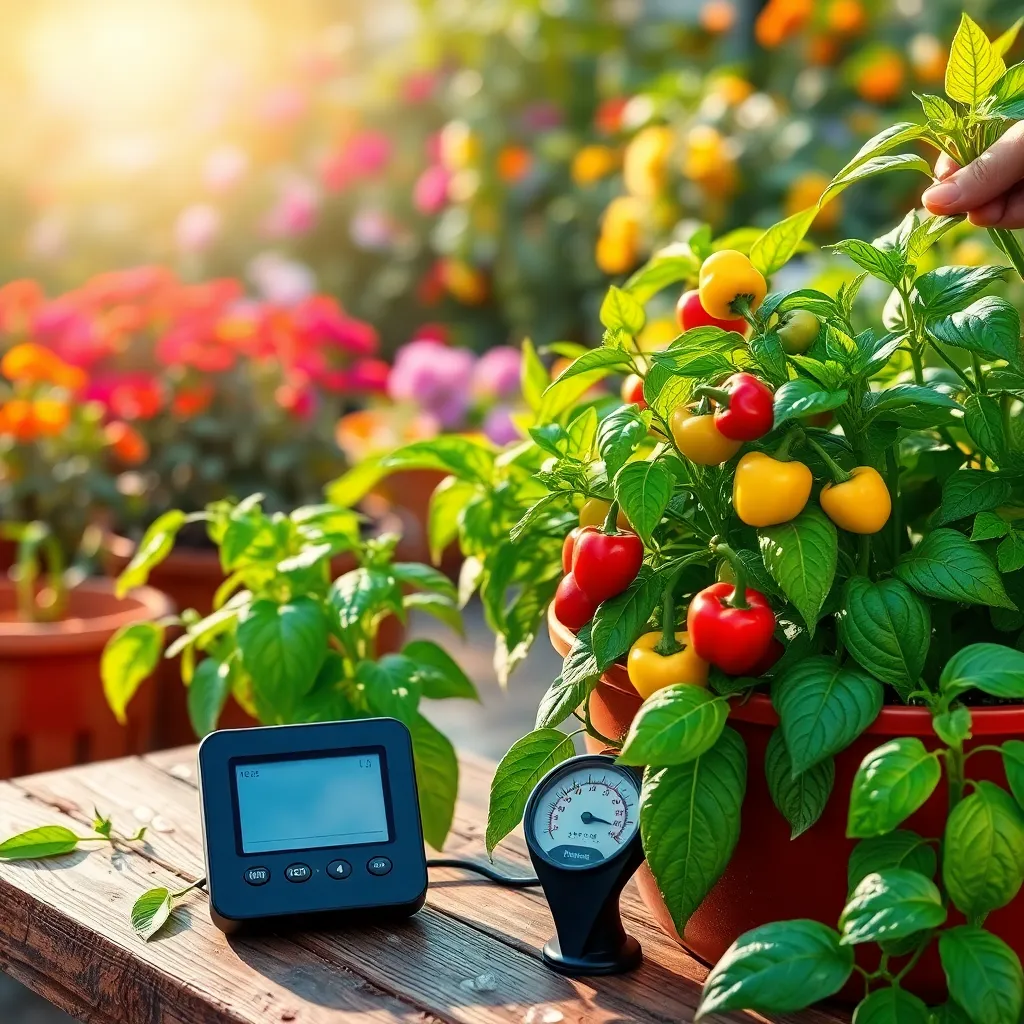
Understanding temperature and humidity is crucial for successfully growing peppers in containers. Peppers thrive in warm conditions, ideally between 70°F to 85°F during the day and not dropping below 55°F at night.
To ensure your plants flourish, monitor nighttime temperatures closely, especially if you’re growing them outdoors. If temperatures dip, consider bringing containers indoors or using a protective cover to maintain warmth.
Humidity also plays a vital role in the health of your pepper plants. While peppers prefer moderate humidity, you can increase moisture by placing a shallow tray of water near your containers or misting the plants occasionally.
For those in particularly dry environments, grouping containers or using a humidifier can help maintain adequate humidity levels. Advanced gardeners can benefit from using a hygrometer to monitor and adjust conditions more precisely, ensuring the perfect environment for pepper growth.
Harvesting Peppers at the Right Time

Timing is crucial when harvesting peppers to ensure the best flavor and texture. Peppers can be harvested at different stages of ripeness, depending on whether you prefer them green, yellow, or fully ripe and red.
It’s important to observe the size and color of your peppers as indicators of readiness. Typically, peppers are ready to pick when they have reached their full size and the skin is firm and glossy.
For those growing peppers in containers, regularly check the plants to catch the optimal harvest window. Container-grown peppers often mature faster due to warmer soil conditions, so staying vigilant is key.
Beginner gardeners should start by harvesting a few peppers early to test flavor and ripeness, adjusting their timing based on taste preferences. Experienced gardeners might experiment with leaving some peppers on the plant longer to sweeten and deepen their flavor.
After harvesting, handle peppers gently to avoid bruising, which can lead to quicker spoilage. Store them in a cool, dry place to maintain their freshness and enjoy them for longer periods.
Overwintering Container Peppers Successfully

Overwintering container peppers allows you to enjoy your plants for multiple seasons, saving you the effort of starting from seed each year. To start, bring your pepper plants indoors before the first frost, ensuring they are placed in a sunny spot with temperatures above 60°F (15°C).
When moving your peppers indoors, it’s essential to check them for pests and treat any infestations promptly. Consider using insecticidal soap or neem oil as a gentle, effective method to keep pests at bay.
Reduce watering during the winter months, as peppers require less moisture when they are not actively growing. Allow the top inch of soil to dry out between waterings, and ensure your container has adequate drainage to prevent root rot.
Prune your pepper plants to remove any dead or damaged foliage, which helps to concentrate the plant’s energy on healthy growth. It’s beneficial to cut back about one-third of the plant, focusing on removing leggy or weak stems.
For those with a bit more experience, consider maintaining a consistent feeding schedule using a balanced, water-soluble fertilizer every four to six weeks. This keeps your peppers healthy and ready to thrive when spring arrives and they can be moved outdoors again.
Conclusion: Growing Success with These Plants
In exploring ’13 Effective Growing Peppers In Containers,’ we’ve delved into essential relationship concepts such as nurturing growth with attention and care, creating the right environment for thriving, and embracing flexibility to adapt to changes. We also discussed the importance of providing support, understanding individual needs, and practicing patience as relationships grow. Just like tending to a pepper plant, relationships flourish when nurtured with communication, dedication, and love.
Now, take a moment to reflect on one area where you can apply these principles in your own relationship. Perhaps it’s offering more support, creating a more nurturing environment, or simply being more patient. Choose one actionable step and commit to it today. By doing so, you’re investing in a healthier, more vibrant partnership.
Remember to bookmark this article as a handy guide for the future. Relationships, like any garden, require ongoing care and attention, and having these key concepts at your fingertips will serve as a valuable resource.
Looking ahead, by consistently applying these nurturing techniques, your relationships are bound to blossom, bringing joy and fulfillment to your life. Embrace the journey, and watch your connections grow stronger each day.

